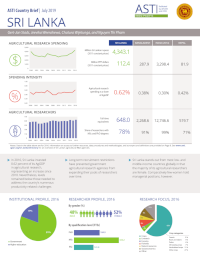Authors:
Padmini Girihagama, Michael Rahija, and Gert-Jan Stads
Year:
2012
Publisher
Back to:
During the first decade of the new millennium, Sri Lanka’s worsening security situation forced the national government to allocate an increasing share of public resources to national security. This was at the expense of other public investments, including agricultural research. Moreover, revenues generated by a cess on plantation crops were gradually channeled away from agricultural R&D. Both factors had a notable impact on the country’s total agricultural R&D spending, which declined by roughly one-third during 2000–2009.
In contrast, the country’s overall number of agricultural researchers increased by 20 percent during the same period. Many of the new scientists, however, were not hired into official research positions, due to restrictions on recruitment instituted by the national government. This deprived these scientists of training opportunities, and other benefits commensurate with their colleagues who did hold full researcher status.
Attracting and retaining high-quality agricultural scientists will remain a key challenge for Sri Lanka’s public agricultural R&D agencies in the coming years. Granting all SLCARP scientists full researcher status would boost motivation and staff morale, and it could be an effective way to counter brain drain.
Another major challenge will be to increase agricultural R&D investment to 1.5 percent of AgGDP, as targeted in the current national plan for agricultural research. Sri Lanka’s 2009 investment levels totaled only 0.34 percent of AgGDP (less than the 0.40 percent of neighboring India). To reach the ambitious 1.5 percent target will require a firm financial and political commitment from government in the coming years.

